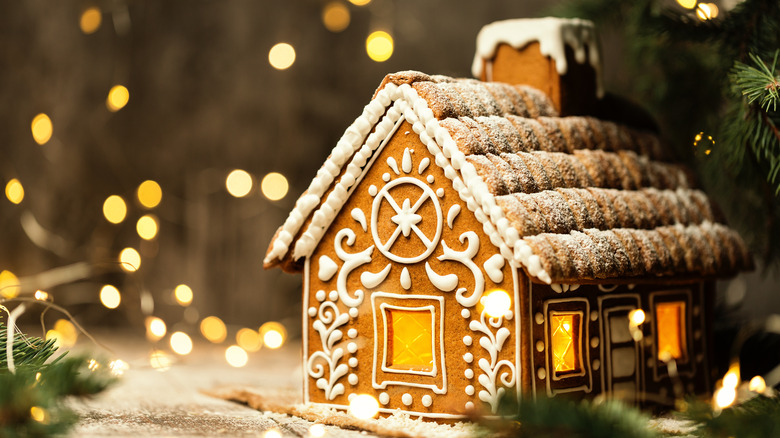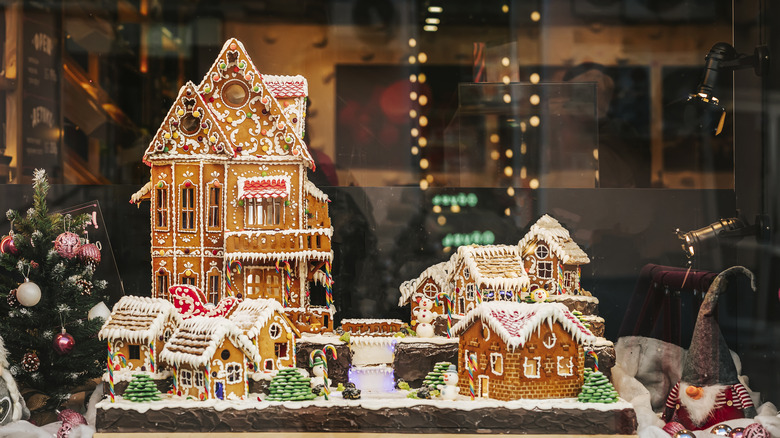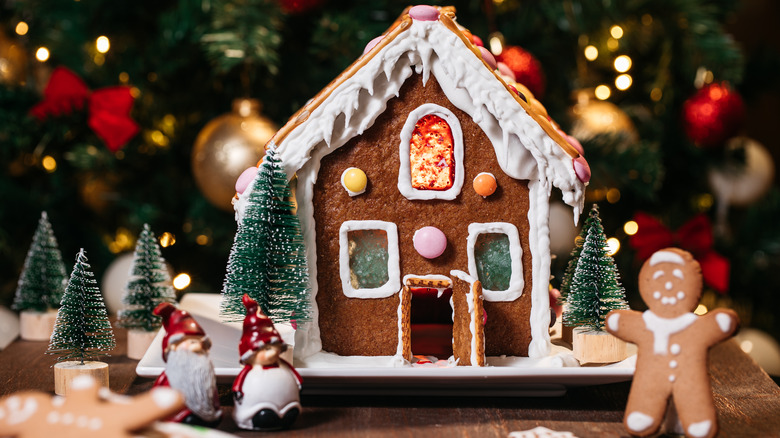How To Store Your Gingerbread House And Avoid Future Renovations
For those of you who love a heaping helping of holiday cheer with a side of suffering, you're probably really into gingerbread houses. Whether you're creating a village of subsidized gingerbread housing, or simply a singular gingerbread mansion, you'll want to make your edible real estate development last. Such a display of cookie opulence must persist through the rolling year! So how are you going to make sure this monument to sugar survives the season? The key is to minimize moisture and keep pests like roaches, mice, and possibly hungry uncles at bay.
If you've already assembled the gingerbread house, you can wrap it in cling wrap or even tent it with foil nightly. If you're wanting to preserve individual pieces to take to a gingerbread house assembly party, make sure you've cut out your pieces correctly to ensure maximum stability, bake them, then wrap them in tinfoil or in an airtight container with paper towel. The same goes for any gingerbread people you may have in tow.
Gingerbread HOA
Just as it is with human domiciles, the construction of your gingerbread house will determine it's longevity. If you've got asymmetrical walls, the chances of one of them coming down are pretty likely. Have you ever heard the phrase "measure twice, cut once"? Not only is it pithy, it's true, so remember it next time you're building your gingerbread house. It's a good idea to have a pattern to cut your gingerbread dough from before baking, as it's easier than free-handing shapes or guessing dimensions of your pieces. To aid in crumbling prevention and temper tantrums, try decorating pieces before assembly.
It isn't only the straight lines of your house you should be worried about but the glue that holds it all together. Many folks use royal icing to glue their gingerbread house parts, but this isn't the only (or even the best) option. Marshmallows and gummies are great binding agents when melted and also act as a sealant to help preserve the life of the construction. Speaking of — because these things are more for the eyes than the mouth, you don't have to make a delicious gingerbread to build with. In fact, omitting eggs in your dough will result in a drier, harder cookie that's great to build with even if it does taste like a dog biscuit. You can't have your gingerbread house and eat it.
Making it last
Once you've built a sturdy, beautiful gingerbread compound, you'll want to store it in optimal conditions. Moisture is the nemesis of the gingerbread, one that has wreaked havoc on the gingerbread people for millennia. If you're a committed gingerbread contractor, you may even consider storing your gingerbread house in a room with a dehumidifier. If you're not set on eating your gingerbread house, there's always varnish. (But seriously: Don't eat it if you lacquer it. There are better ways to ruin the holidays.)
Perhaps the best and most practical way to store finished gingerbread houses is on display in a glass cake cover or even a decorative bell jar, if you're really committed to the bit. This approach kills all the storage birds with one stone, creating a beautiful shield around the gingerbread house so everybody can ooh and ahh while being securely tucked under glass away from sneaky fingers and kitchen humidity. If you do find yourself in need of mild (if frustrating) gingerbread repair, frosting will always help.


